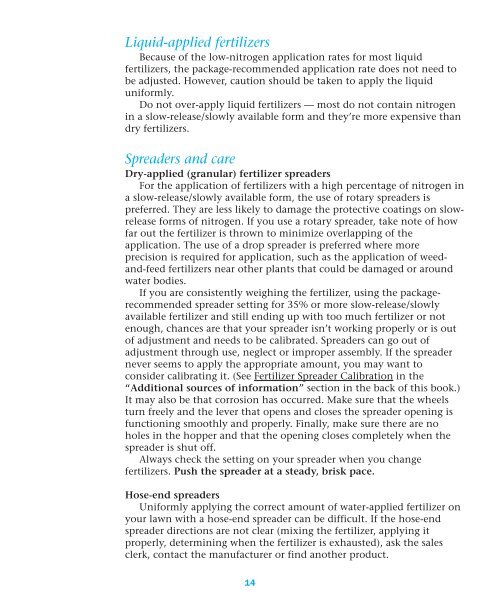What You Need to Know About Fertilizing and Watering - Southwest ...
What You Need to Know About Fertilizing and Watering - Southwest ...
What You Need to Know About Fertilizing and Watering - Southwest ...
Create successful ePaper yourself
Turn your PDF publications into a flip-book with our unique Google optimized e-Paper software.
Liquid-applied fertilizers<br />
Because of the low-nitrogen application rates for most liquid<br />
fertilizers, the package-recommended application rate does not need <strong>to</strong><br />
be adjusted. However, caution should be taken <strong>to</strong> apply the liquid<br />
uniformly.<br />
Do not over-apply liquid fertilizers — most do not contain nitrogen<br />
in a slow-release/slowly available form <strong>and</strong> they’re more expensive than<br />
dry fertilizers.<br />
Spreaders <strong>and</strong> care<br />
Dry-applied (granular) fertilizer spreaders<br />
For the application of fertilizers with a high percentage of nitrogen in<br />
a slow-release/slowly available form, the use of rotary spreaders is<br />
preferred. They are less likely <strong>to</strong> damage the protective coatings on slowrelease<br />
forms of nitrogen. If you use a rotary spreader, take note of how<br />
far out the fertilizer is thrown <strong>to</strong> minimize overlapping of the<br />
application. The use of a drop spreader is preferred where more<br />
precision is required for application, such as the application of weed<strong>and</strong>-feed<br />
fertilizers near other plants that could be damaged or around<br />
water bodies.<br />
If you are consistently weighing the fertilizer, using the packagerecommended<br />
spreader setting for 35% or more slow-release/slowly<br />
available fertilizer <strong>and</strong> still ending up with <strong>to</strong>o much fertilizer or not<br />
enough, chances are that your spreader isn’t working properly or is out<br />
of adjustment <strong>and</strong> needs <strong>to</strong> be calibrated. Spreaders can go out of<br />
adjustment through use, neglect or improper assembly. If the spreader<br />
never seems <strong>to</strong> apply the appropriate amount, you may want <strong>to</strong><br />
consider calibrating it. (See Fertilizer Spreader Calibration in the<br />
“Additional sources of information” section in the back of this book.)<br />
It may also be that corrosion has occurred. Make sure that the wheels<br />
turn freely <strong>and</strong> the lever that opens <strong>and</strong> closes the spreader opening is<br />
functioning smoothly <strong>and</strong> properly. Finally, make sure there are no<br />
holes in the hopper <strong>and</strong> that the opening closes completely when the<br />
spreader is shut off.<br />
Always check the setting on your spreader when you change<br />
fertilizers. Push the spreader at a steady, brisk pace.<br />
Hose-end spreaders<br />
Uniformly applying the correct amount of water-applied fertilizer on<br />
your lawn with a hose-end spreader can be difficult. If the hose-end<br />
spreader directions are not clear (mixing the fertilizer, applying it<br />
properly, determining when the fertilizer is exhausted), ask the sales<br />
clerk, contact the manufacturer or find another product.<br />
14
















